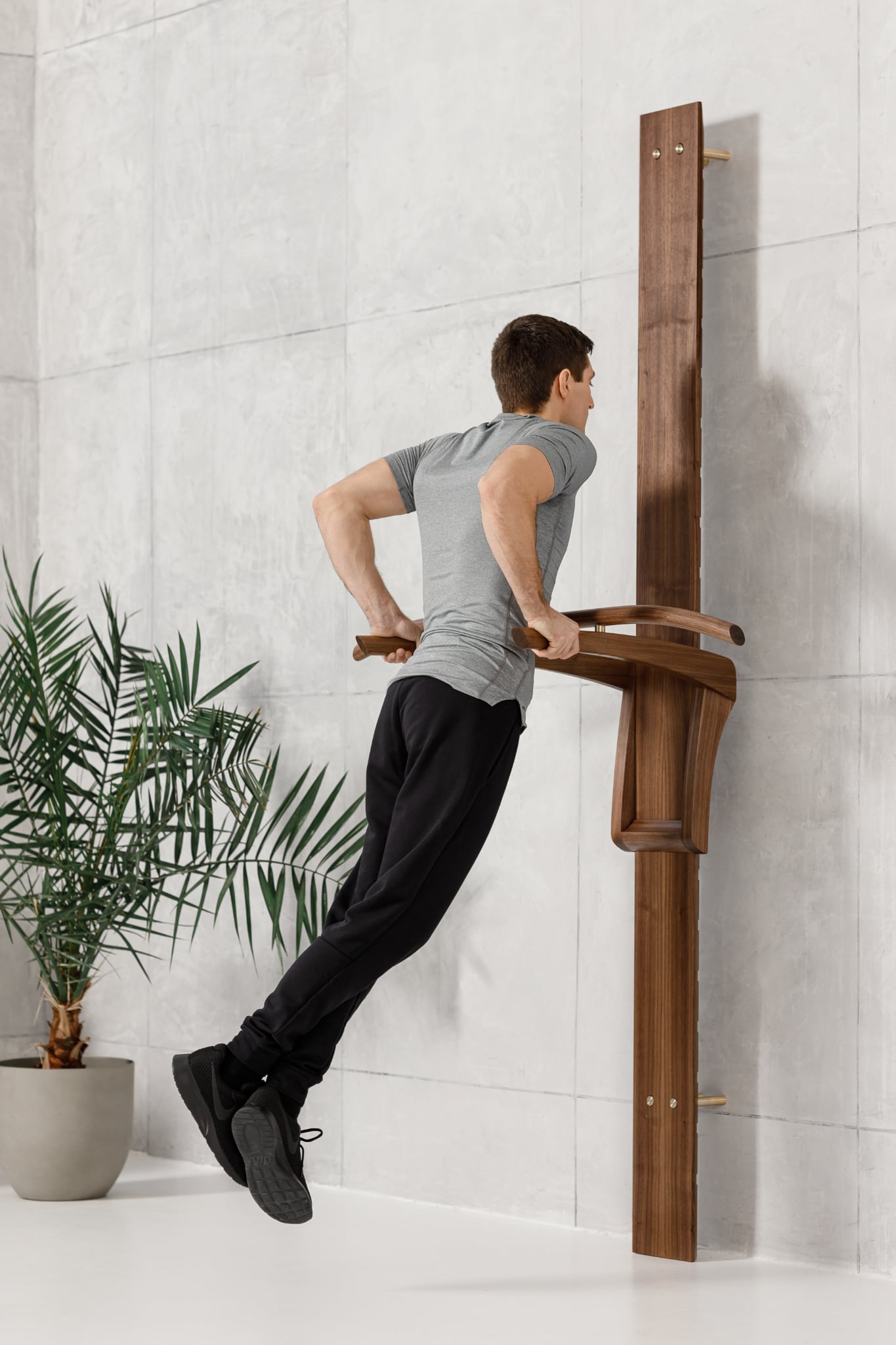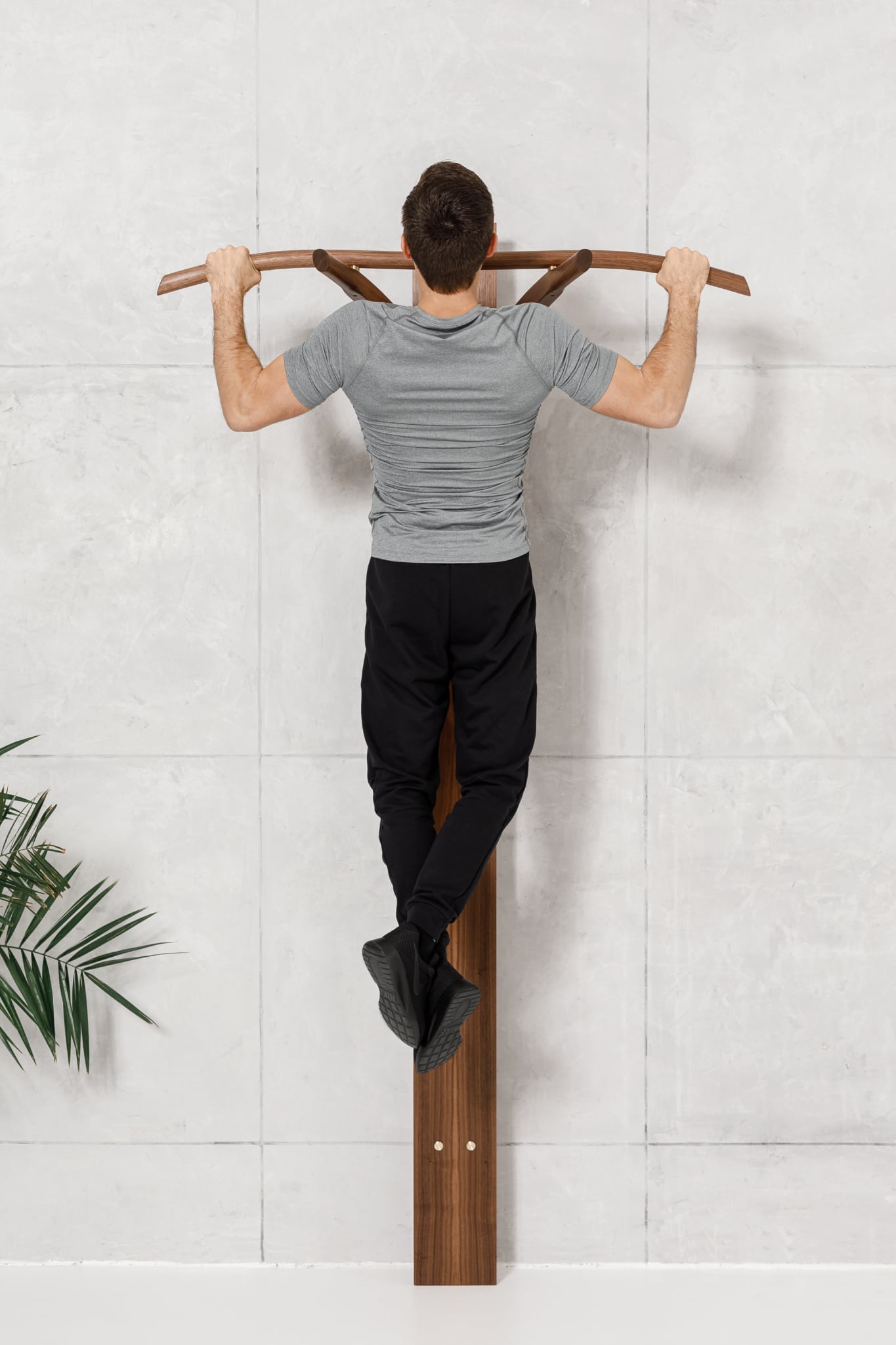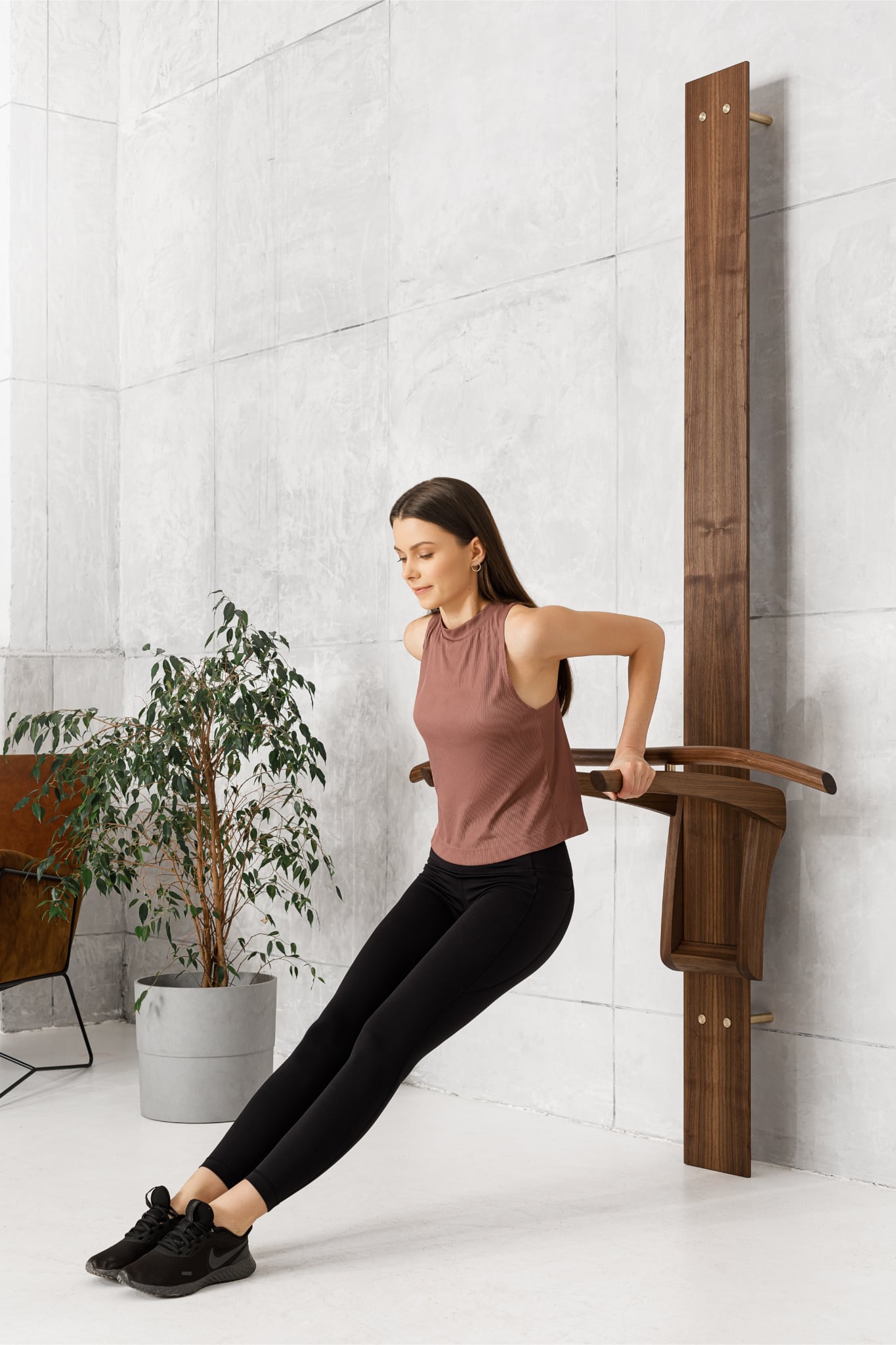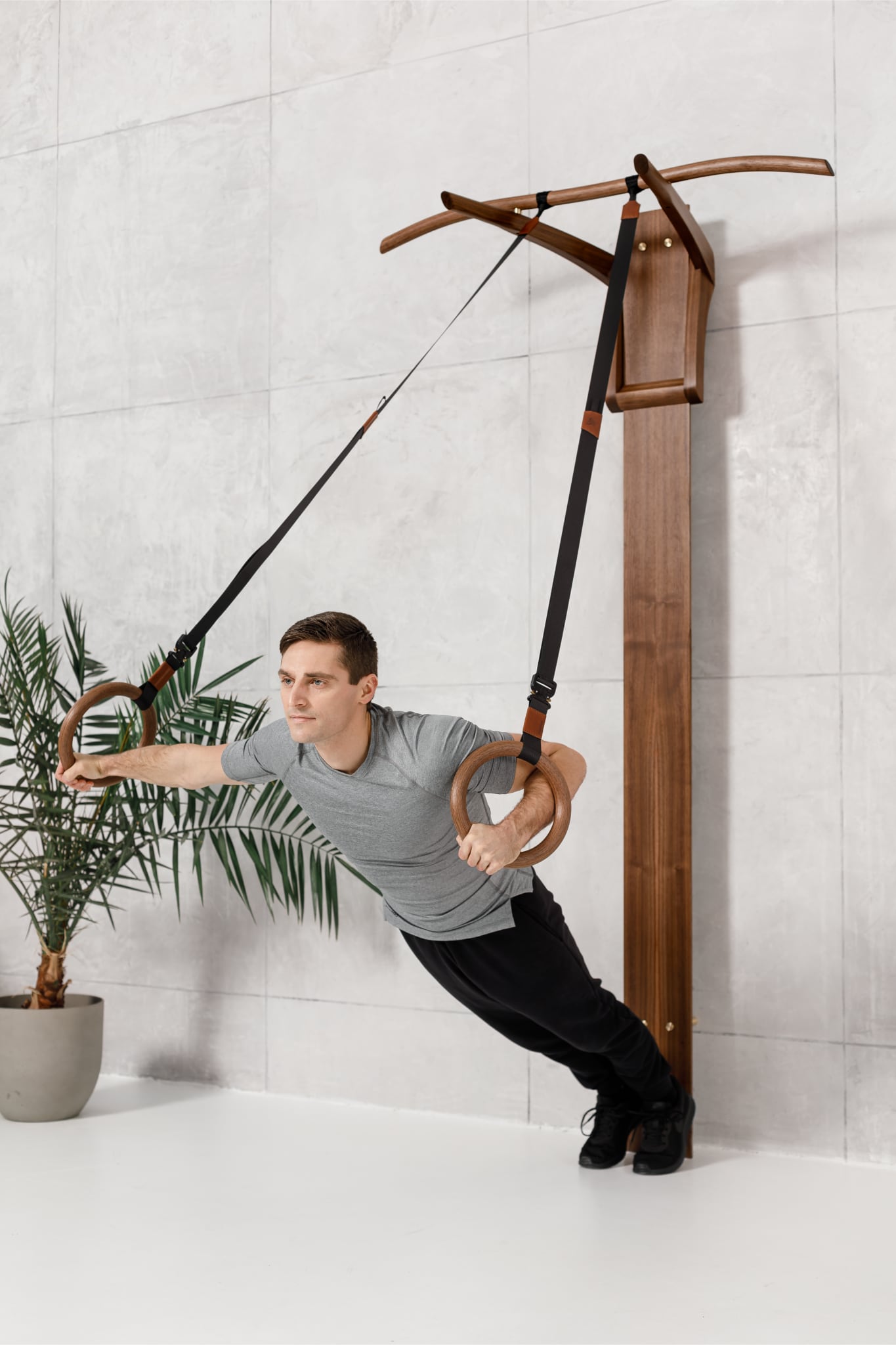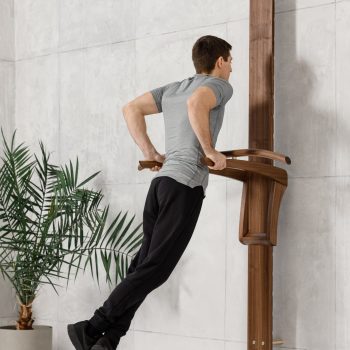 BOW Pull-up & Dip Station
BOW Pull-up & Dip StationBOW Pull-up & Dip Station
From 2060,00 €
Including shipping & taxesInspired by a classic power tower, the BOW Pull-Up & Dip Station merges the utility of home gym equipment with aesthetic sophistication. With a pull up bar and dip bars integrated into an adjustable height bracket, this innovative piece is in a category of its own.
Every detail – from the thoughtful design down to the brushed metal elements that discreetly conceal installation screws – speaks of its long-lasting quality and our commitment to sustainability. The wide, ergonomically designed pull up bar supports various grip techniques, while the subtly angled dip bars cater to individuals across a spectrum of body types. Changing the bar height is straightforward, and a handy safety pin ensures safety during your workout. Handmade in our workshop using premium hardwoods, this Pull Up & Dip Station is as sturdy as it is elegant.
– Compatible with solid and timber frame walls
– Traditional wood joinery for added strength
– Effortless height adjustment
– Ergonomically shaped pull up bar
– Brushed metal plugs for concealed installation
– Metal pin to lock the bars in place
Package Contents
- Main board × 1
- Dip bars × 1
- Pull-up bar × 1
- Wooden mounting blocks (indirect installation) × 2
- Long hollow brass supports for main board × 4
- Short hollow brass supports for pull-up bar × 2
- Brass plugs with rubber rings × 4
- Brass safety pin × 1
- Expansion fasteners for solid walls (direct installation) × 4
- Bolt, nut and washer sets (indirect installation) × 4
- Wood screws for pull-up bar × 2
- Screwdriver bits
Note: Wooden mounting blocks, long hollow brass supports, bolts, nuts and washers come assembled. These units need to be disassembled before installation of the main board. If direct installation method is chosen (see below), only long hollow brass supports will be used.
Choosing Installation Method
There are two methods to install the main board:
- Direct installation without mounting blocks:
- This installation method gives a clean, contemporary look.
- Wall fasteners go through the main board, through the long hollow brass supports and straight into the wall.
- Wooden mounting blocks, bolts, nuts and washers are not used. Hollow brass supports rest directly on the wall.
- This installation method is only suitable when solid surface is present at all four fixing locations, e.g. solid concrete or masonry walls, timber frame walls with prepositioned solid timber elements.
- This method does not work with regular timber frame wall studs – studs are too narrow to accept two fasteners side by side at predefined locations.
- This method is not recommended for walls that have a particularly soft surface as brass supports may crush the surface of the wall.
- Expansion fasteners for direct installation on solid concrete or masonry walls are included. Fasteners for other types of walls must be selected and sourced by the installer.
- Indirect installation with mounting blocks:
- This installation method is suitable when direct installation is not possible or is not desired.
- Bolts with washers go through the main board, through the long hollow brass supports, through wooden mounting blocks into square nuts located on the back side of mounting blocks.
- Mounting blocks are attached to the wall by drilling/screwing through them (at a central location between brass supports) and fastening them to the wall using suitable fasteners.
- Two wall fasteners should be used per mounting block for safety reasons.
- Wall fasteners needed to attach mounting blocks to the wall must be selected and sourced by the installer.
Direct Installation on Concrete or Masonry Walls
- After choosing a suitable location for installation, place the main board against the wall and precisely mark locations of the four fixing points.
- Drill four 10 mm (0.4″) holes 90 mm (3.5″) deep into the wall at each marked location and vacuum dust from the holes.
- Attach four hollow brass supports to the back of the main board and insert nylon expansion fasteners through the front of the main board.
- Place dip bars on the main board and insert brass safety pin to keep dip bars in place.
- Place the main board (with dip bars attached) against the wall, insert four nylon expansion fasteners fully into four holes and fasten metal screws until the main board is properly fixed to the wall. Do not over-tighten metal screws as brass supports may crush the surface of the wall.
- Insert decorative brass plugs to conceal fasteners.
Direct Installation on Other Types of Walls
Follow direct installation instructions for concrete or masonry walls but adapt based on your choice of fasteners – you may or may not need to drill holes into the wall or the holes may need to be of different diameter and/or depth.
Indirect Installation
- Attach four hollow brass supports to the back of the main board, attach wooden mounting blocks to brass supports, insert bolts with washers through the main board, through brass supports and through mounting blocks and fasten them to square nuts located on the other side of the mounting blocks.
- After choosing a suitable location for installation, place the main board against the wall and precisely mark locations of the mounting blocks.
- Remove mounting blocks from brass supports and fasten mounting blocks to the wall at marked locations using suitable fasteners.
- Place dip bars on the main board and insert brass safety pin to keep dip bars in place.
- Place the main board (with dip bars attached) against the wall and insert brass supports into mounting blocks.
- Fasten bolts tightly until the main board is hold securely in place.
- Insert decorative brass plugs to conceal bolts.
Installation of Pull-up Bar
- Place short hollow brass supports into the two shallow round slots on dip bars.
- Take pull-up bar with shallow round slots facing down and place the bar on the brass supports so that the round slots fit over the brass supports.
- While firmly holding the pull-up bar in place, drive the wood screws from below the dip bars until the pull-up bar is properly fastened.
Note: Shallow rounds slots on the pull-up bar may not align perfectly with corresponding slots on dip bars due to manufacturing tolerances. If this happens, slightly pull dip bars towards each other or spread them outwards until they align.
Changing Height of Bars
- Remove safety pin.
- Tilt the unit slightly so that the round brass bar comes out of the horizontal slot on the main board.
- Move the unit up or down in a controlled manner.
- Tilt the unit back so that the round brass bar comes into one of the horizontal slots on the main board.
- Insert safety pin into appropriate hole on the back of the main board to prevent the unit from falling down accidentally.
Warning! Make sure that either the safety pin is engaged or the main unit is held firmly at all times. Failure to do so may result in damage to the product, damage to your property, human injury or death if the main unit falls down.
